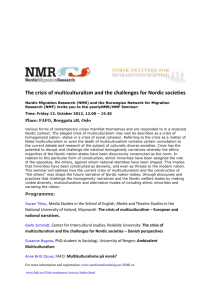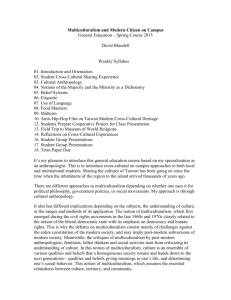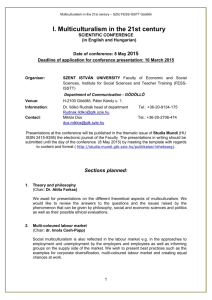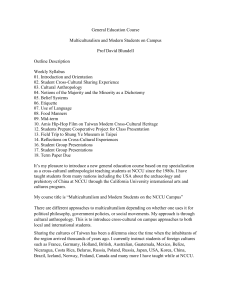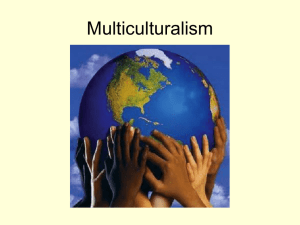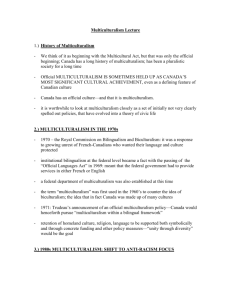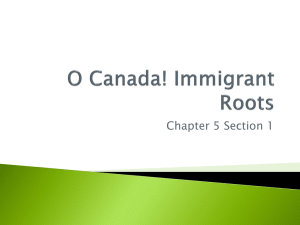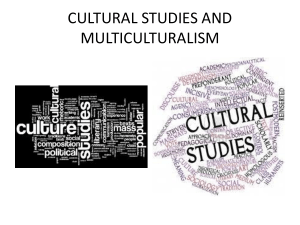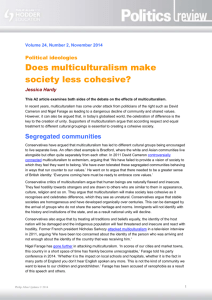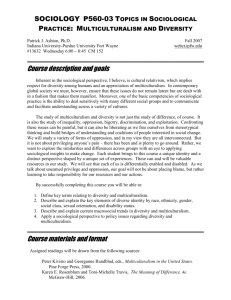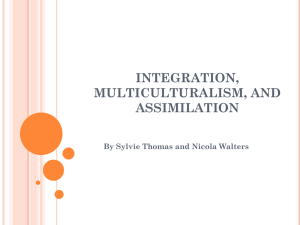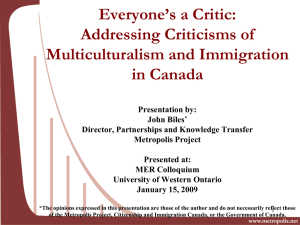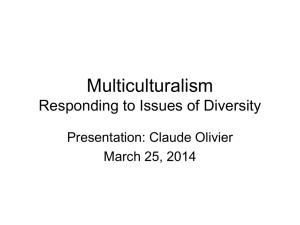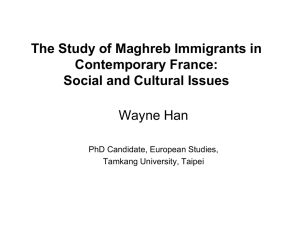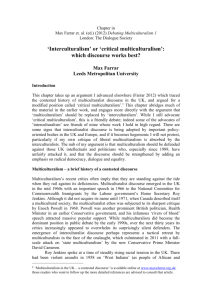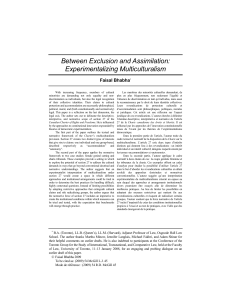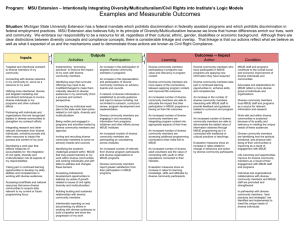Significant difference powerpoint presentation
advertisement
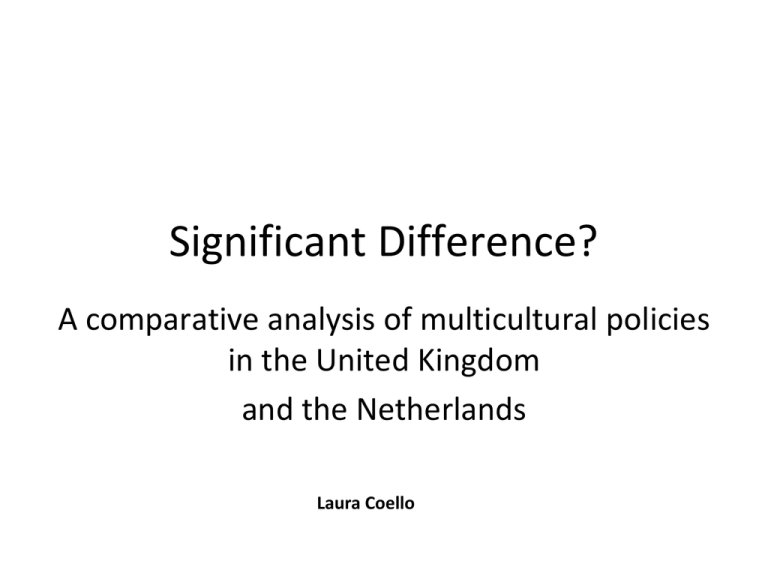
Significant Difference? A comparative analysis of multicultural policies in the United Kingdom and the Netherlands Laura Coello The presentation • Introduction: The choice in policies • Comparing UK and NL Did multiculturalism fail? – Q1: Why did these countries adopt multiculturalism? – Q2: Based on which aims and objectives did NL and UK adopt multiculturalism? – Q3: Based on these objectives, did multiculturalism fail? • Conclusion Figure 1: Conceptual model of study multiculturalism fail? Antidiscrimination Labour market participation Introduction: the choice in policies • Context of the study: – Who is part of the nation, who is not? – What to do about those who are not? • 3 ideal models to deal with diversity: Allowed to manifest different identities or cultures Private sphere Public sphere Assimilation NO NO Integration YES NO Multiculturalism YES YES Introduction: the choice in policies • Different interpretations of multiculturalism: – Strong: right to choose ‘good life’ and group’s rights – Weak: right to choose ‘good life’ and institutional adaptations to create equal opportunities for all • Weak multicultural policies: • • • • • • respect the right of personal identity explicitly recognise this right Allows these identities in both the public and private sphere Do not try to impose a ´common´ identity Provide the same space for alternative identities May require adjustments of institutions, norms and behaviours. Comparing UK and NL • In UK and NL – Originally ‘national unions’ – Centralising tendencies: • Henry VIII • Revolts against Spain – Colonialism – Decolonisation – Even today citizens in, for instance, Bermuda and Aruba NL 1958 1962 1965 Ra ce on m Co m in w Im m gh am ea lth No tti n an d No t 1968 1971 1976 1977 Hostage s taken by Maluku activists 1979 Scientifi c Council for Govern ment Policy Report: Ethnic minoriti es 1983 1984 Introdu ction of a prohibi tion of discrim ination in the constit ution 1985 1986 Creatio n of the Nation al bureau against discrim ination (LBR) 1987 1988 Public financin g of Muslim and Hindu schools 1989 New WRR report "minorit y policies" 1994 Fair Employ ment of Ethnic Minoriti es Act: registrat ion of minoriti es in their workfor ce rd , da rd s an st La Sca w rm re a Ra nce n Re ce In po q eq Rel uir rt: ua ati y Th e o li St RR ty s ns ( ep ch Am A he e n ac Reg me end co ul s m un ati en t o 3 t) or abi ns Ac ga lit : p t: y fo ni o Ra , s r E sa eq it ce qu tio uit ive n y al du s p ity m t l an erg an y, d e Hu in m to an Co R i mm gh ts issi : C on RE Lo e, de gu s of id p el ra in ct es ic Co Se tin g Re i l gr at co at io nd ns io n Ra Ac Ac c t e Co t R m e la tio Re mon ns st w r e Ac En ictiv alth t ac e I m i of tme mm mi re nt igr gra fe o a t Cr ren f th tion ion ea ce e R p A c t ac olic t : Eq ion eR y u a of ela lit th y e tio (C Co ns RE m Ac ) m t iss io n fo rR ac ia l Th e M la an w on dla re vs D lig o io w us el di l Le Co sc e nc rim ca ep in se: to at f io cas s Eq n e ys ua te m lo i cd pp or isc tu rim ni tie in at sp io ol n icy st st Fir Fir cia Hi l rio ll ts Ra UK Q1: Why did these countries adopt multiculturalism? 1999 2000 1998 New 3 Ministry national for organisa Metrop tions olitan merge Affairs into LBR and Integrat ion, SAMEN Act 2003 Abolitio n of the SAMEN Act, Integrat ion Policy New Style 2006 2007 LBR, local and regiona l antidiscrim ination agenci es becom e Art. 1 Q2: Based on which aims and objectives did the UK adopt multiculturalism? – To challenge • prejudice, disadvantage • enforce equality legislation • Elimination of inequalities and discrimination and strengthen good relations between people – Consistency: • implemented at an early stage and given continuity to these policies Q2: Based on which aims and objectives did the NL adopt multiculturalism? • Challenging as the (focus of the) answer shifts • WRR advice often accompanied by shifts in – paradigm – solution – departments • lack of consistency – Thorough anti-discrimination legislation, – but assimilative form of integration Q3: Based on these aims and objectives did multiculturalism fail? UK NL Would you describe yourself as … ? (%) 1985 1989 1991 1992 1993 2 1980 39** 2008 2005* 1983 Very racially prejudiced against people from other races Tendency to discriminate against minorities (%) 30 31 35 41 41 3 Tendency A little racially prejudiced against people from other races 23 17 Not prejudiced at all 75 79 Don't know 1 * *2005 BBC Multiculturalism Survey, conducted by telephone ** Park, Curtice, Thomson, Jarvis, Bromley (2004). 49 Scheepers & Coenders (1996). Q3: Based on these aims and objectives did multiculturalism fail? UK NL Prejudice in the British society (2007) Ethnic prejudice in 3 situations (1979 -2002) 100 100 90 90 80 80 70 70 Never feel any prejudice 60 60 50 Sometimes feel prejudiced but try not to let it show 50 40 Don’t mind if I come across as prejudiced 40 30 Dismiss/ fire individual from minority Available house to Dutch family 30 20 20 10 10 0 Promote native Dutch 0 Disabled people Black people Muslim People Gay/ people aged 70+ lesbians Source: Equalities Review (2007). pp. 92 Women 1978- 1981- 1985- 1988- 1991- 1994- 1997- 2002- 2004- 200879 82 86 89 92 95 98 03 05 09 Source: SCP in Coenders, Lubbers & Scheepers (2006) Q3 UK NL Compliance with diversity regulations 1998-2004 Diversity policies and their results in 2003 % % 100 100 90 90 80 80 70 70 60 60 50 40 50 30 40 20 30 10 20 0 private public private Presence of equal opportunities policy* Keeping employee records w ith ethnic origin identified* 1998 Source: UK: Kersley et al (2006) NL: De Vries et al (2005). public 10 0 2004 Private sector Recruit minorities Public Sector Promote minorities Compliance with the SAMEN Act (%) Compliance Source: Houtzager & Rodrigues (2002) 1998 2001 49 72 Minorities in organisation Q3 UK Difference in immigrant and native male employment rates between 1980-2001 in the UK* UK Natives mean Immigrants mean Difference 92.0% 87.6% 4.4% Source: Tubergen, Maas & Flap (2004) pp. 715 *Data show percentages of active male population between the ages of 25-54 years. NL Difference in immigrant and native male employment rates between 1980-2001 in NL* Netherlands Natives mean Immigrants mean Difference 96.8% 84.0% 12.8% Source: Tubergen, Maas & Flap (2004) pp. 715 *Data show percentages of active male population between the ages of 25-54 years. Conclusion 1 • United Kingdom: – – – – long-term policies reduced prejudices against (some) minorities enabled positive relations between groups High compliance with equal opportunities policies (voluntary for private sector!) – labour market participation of minorities almost equal as native counterparts • The Netherlands: – – – – Decrease of (some) prejudices against minorities labour market policies short-lived Low continuation of diversity policies (voluntary) labour market participation of minorities much lower than native counterparts Conclusion 2 • Absence of an underlying commitment to embrace and institutionalise diversity – Integration needs result in assimilation? • Difference between (government) rhetoric and actual policies: – Multiculturalism dead, but individual differences still allowed in public sphere – International commitments VS. pursuing assimilative policies – Warning for contradictory policies and discourse
